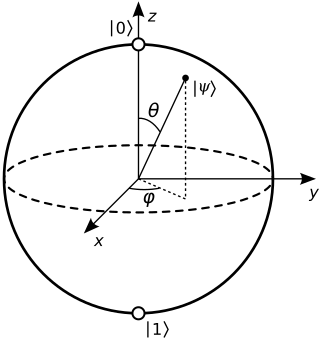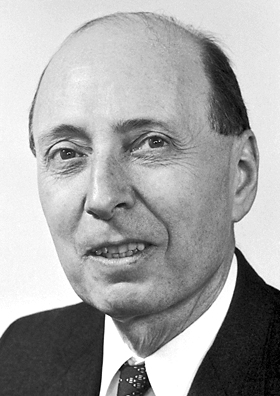The mathematical formulations of quantum mechanics are those mathematical formalisms that permit a rigorous description of quantum mechanics. This mathematical formalism uses mainly a part of functional analysis, especially Hilbert spaces, which are a kind of linear space. Such are distinguished from mathematical formalisms for physics theories developed prior to the early 1900s by the use of abstract mathematical structures, such as infinite-dimensional Hilbert spaces, and operators on these spaces. In brief, values of physical observables such as energy and momentum were no longer considered as values of functions on phase space, but as eigenvalues; more precisely as spectral values of linear operators in Hilbert space.
In linear algebra, the trace of a square matrix A, denoted tr(A), is defined to be the sum of elements on the main diagonal of A. The trace is only defined for a square matrix.
In quantum mechanics, a density matrix is a matrix that describes the quantum state of a physical system. It allows for the calculation of the probabilities of the outcomes of any measurement performed upon this system, using the Born rule. It is a generalization of the more usual state vectors or wavefunctions: while those can only represent pure states, density matrices can also represent mixed states. Mixed states arise in quantum mechanics in two different situations:
- when the preparation of the system is not fully known, and thus one must deal with a statistical ensemble of possible preparations, and
- when one wants to describe a physical system that is entangled with another, without describing their combined state; this case is typical for a system interacting with some environment.
In mathematics, a self-adjoint operator on a complex vector space V with inner product is a linear map A that is its own adjoint. If V is finite-dimensional with a given orthonormal basis, this is equivalent to the condition that the matrix of A is a Hermitian matrix, i.e., equal to its conjugate transpose A∗. By the finite-dimensional spectral theorem, V has an orthonormal basis such that the matrix of A relative to this basis is a diagonal matrix with entries in the real numbers. This article deals with applying generalizations of this concept to operators on Hilbert spaces of arbitrary dimension.
In mathematics, specifically functional analysis, a trace-class operator is a linear operator for which a trace may be defined, such that the trace is a finite number independent of the choice of basis used to compute the trace. This trace of trace-class operators generalizes the trace of matrices studied in linear algebra. All trace-class operators are compact operators.
In quantum physics, a measurement is the testing or manipulation of a physical system to yield a numerical result. A fundamental feature of quantum theory is that the predictions it makes are probabilistic. The procedure for finding a probability involves combining a quantum state, which mathematically describes a quantum system, with a mathematical representation of the measurement to be performed on that system. The formula for this calculation is known as the Born rule. For example, a quantum particle like an electron can be described by a quantum state that associates to each point in space a complex number called a probability amplitude. Applying the Born rule to these amplitudes gives the probabilities that the electron will be found in one region or another when an experiment is performed to locate it. This is the best the theory can do; it cannot say for certain where the electron will be found. The same quantum state can also be used to make a prediction of how the electron will be moving, if an experiment is performed to measure its momentum instead of its position. The uncertainty principle implies that, whatever the quantum state, the range of predictions for the electron's position and the range of predictions for its momentum cannot both be narrow. Some quantum states imply a near-certain prediction of the result of a position measurement, but the result of a momentum measurement will be highly unpredictable, and vice versa. Furthermore, the fact that nature violates the statistical conditions known as Bell inequalities indicates that the unpredictability of quantum measurement results cannot be explained away as due to ignorance about "local hidden variables" within quantum systems.

In quantum mechanics and computing, the Bloch sphere is a geometrical representation of the pure state space of a two-level quantum mechanical system (qubit), named after the physicist Felix Bloch.
In linear algebra and functional analysis, the partial trace is a generalization of the trace. Whereas the trace is a scalar valued function on operators, the partial trace is an operator-valued function. The partial trace has applications in quantum information and decoherence which is relevant for quantum measurement and thereby to the decoherent approaches to interpretations of quantum mechanics, including consistent histories and the relative state interpretation.
In quantum information theory, a quantum channel is a communication channel which can transmit quantum information, as well as classical information. An example of quantum information is the state of a qubit. An example of classical information is a text document transmitted over the Internet.
In mathematics, particularly in functional analysis, a projection-valued measure is a function defined on certain subsets of a fixed set and whose values are self-adjoint projections on a fixed Hilbert space. A projection-valued measure (PVM) is formally similar to a real-valued measure, except that its values are self-adjoint projections rather than real numbers. As in the case of ordinary measures, it is possible to integrate complex-valued functions with respect to a PVM; the result of such an integration is a linear operator on the given Hilbert space.
In physics, the no-communication theorem or no-signaling principle is a no-go theorem from quantum information theory which states that, during measurement of an entangled quantum state, it is not possible for one observer, by making a measurement of a subsystem of the total state, to communicate information to another observer. The theorem is important because, in quantum mechanics, quantum entanglement is an effect by which certain widely separated events can be correlated in ways that, at first glance, suggest the possibility of communication faster-than-light. The no-communication theorem gives conditions under which such transfer of information between two observers is impossible. These results can be applied to understand the so-called paradoxes in quantum mechanics, such as the EPR paradox, or violations of local realism obtained in tests of Bell's theorem. In these experiments, the no-communication theorem shows that failure of local realism does not lead to what could be referred to as "spooky communication at a distance".

Wigner's theorem, proved by Eugene Wigner in 1931, is a cornerstone of the mathematical formulation of quantum mechanics. The theorem specifies how physical symmetries such as rotations, translations, and CPT transformations are represented on the Hilbert space of states.
In functional analysis and quantum information science, a positive operator-valued measure (POVM) is a measure whose values are positive semi-definite operators on a Hilbert space. POVMs are a generalization of projection-valued measures (PVM) and, correspondingly, quantum measurements described by POVMs are a generalization of quantum measurement described by PVMs.
In mathematics, Stinespring's dilation theorem, also called Stinespring's factorization theorem, named after W. Forrest Stinespring, is a result from operator theory that represents any completely positive map on a C*-algebra A as a composition of two completely positive maps each of which has a special form:
- A *-representation of A on some auxiliary Hilbert space K followed by
- An operator map of the form T ↦ V*TV.
In mathematics, Choi's theorem on completely positive maps is a result that classifies completely positive maps between finite-dimensional (matrix) C*-algebras. An infinite-dimensional algebraic generalization of Choi's theorem is known as Belavkin's "Radon–Nikodym" theorem for completely positive maps.
In operator theory, a bounded operator T: X → Y between normed vector spaces X and Y is said to be a contraction if its operator norm ||T || ≤ 1. This notion is a special case of the concept of a contraction mapping, but every bounded operator becomes a contraction after suitable scaling. The analysis of contractions provides insight into the structure of operators, or a family of operators. The theory of contractions on Hilbert space is largely due to Béla Szőkefalvi-Nagy and Ciprian Foias.
In physics, a quantum instrument is a mathematical abstraction of a quantum measurement, capturing both the classical and quantum outputs. It combines the concepts of measurement and quantum operation. It can be equivalently understood as a quantum channel that takes as input a quantum system and has as its output two systems: a classical system containing the outcome of the measurement and a quantum system containing the post-measurement state.
In quantum mechanics, and especially quantum information and the study of open quantum systems, the trace distanceT is a metric on the space of density matrices and gives a measure of the distinguishability between two states. It is the quantum generalization of the Kolmogorov distance for classical probability distributions.
In mathematics, there are many kinds of inequalities involving matrices and linear operators on Hilbert spaces. This article covers some important operator inequalities connected with traces of matrices.
In quantum information theory and operator theory, the Choi–Jamiołkowski isomorphism refers to the correspondence between quantum channels and quantum states, this is introduced by Man-Duen Choi and Andrzej Jamiołkowski. It is also called channel-state duality by some authors in the quantum information area, but mathematically, this is a more general correspondence between positive operators and the complete positive superoperators.

































